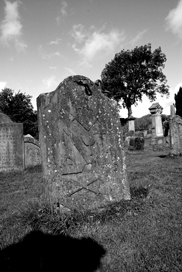Houston Paterson
A young hero
1820 –1831
Although his name does not appear on it, this handsome stone marks the resting place of Houston Paterson, a young local lad who died in tragic circumstances.
In the early afternoon of New Year’s Day 1831, eleven-year old Houston was playing with some friends on the ice at the unfenced Burgh Mill dam (at the rear of what is now the Thistle Centre). Unfortunately, a thaw had set in the previous day, and as the youngsters cheerfully slid and slithered about, the ice gave way and one of the lads fell through. Unhesitatingly, Houston rushed to help his friend, a boy named Tait, but his weight was too much for the thinning ice and he too went in. With the help of bystander Mr McVey, a weaver, Tait was pulled free of the freezing water, but by then Houston had slid right underneath the ice. Although he could be seen struggling, he was out of reach of any help and only after the dam had been drained could his body be retrieved. Houston was the elder son of Houston Paterson, a joiner, and his wife Susan MacLachlan who lived in Spittal Street. It is ironic that, in a period of high child mortality, Houston should have survived the usual childhood fatalities and perished in such a way.
The stone was the property of Robert Taylor, a mason in the burgh. In Stirlingshire it was not uncommon for the well-to-do to have their gravestone set up during their own lifetime, so that the stone could be shown off and admired as an indication of the owner’s wealth and standing.
Emblems of trade date back to Roman times but in Scotland date only from the seventeenth century. Even after a period of well over two hundred years, the symbols here show clearly the wedges, mell, and other tools of a mason’s trade.
According to the Stirling Old Parish Records, others, outwith the Taylor family, also lie at rest here.

